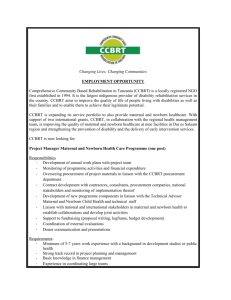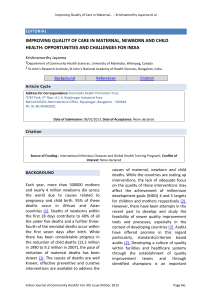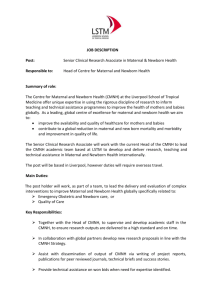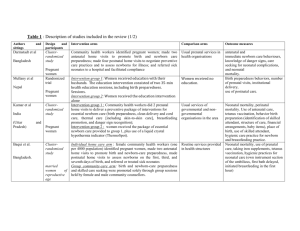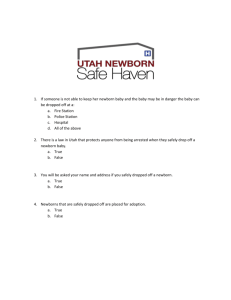Maternal and Newborn Care Health Facility Checklist
advertisement
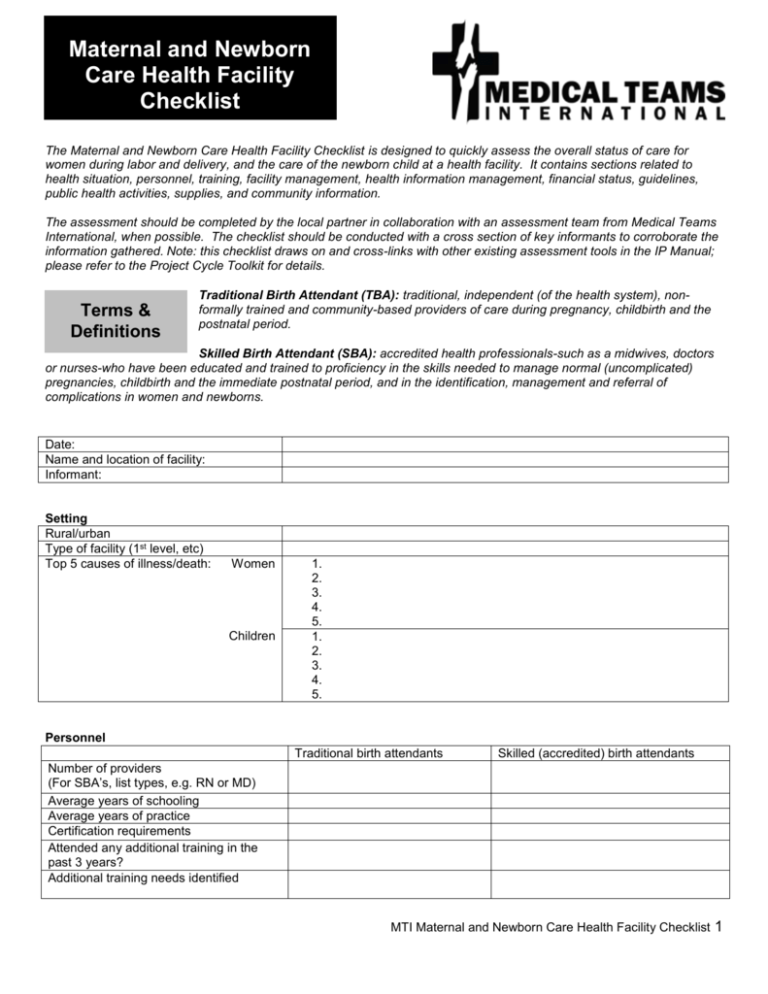
Maternal and Newborn Care Health Facility Checklist The Maternal and Newborn Care Health Facility Checklist is designed to quickly assess the overall status of care for women during labor and delivery, and the care of the newborn child at a health facility. It contains sections related to health situation, personnel, training, facility management, health information management, financial status, guidelines, public health activities, supplies, and community information. The assessment should be completed by the local partner in collaboration with an assessment team from Medical Teams International, when possible. The checklist should be conducted with a cross section of key informants to corroborate the information gathered. Note: this checklist draws on and cross-links with other existing assessment tools in the IP Manual; please refer to the Project Cycle Toolkit for details. Terms & Definitions Traditional Birth Attendant (TBA): traditional, independent (of the health system), nonformally trained and community-based providers of care during pregnancy, childbirth and the postnatal period. Skilled Birth Attendant (SBA): accredited health professionals-such as a midwives, doctors or nurses-who have been educated and trained to proficiency in the skills needed to manage normal (uncomplicated) pregnancies, childbirth and the immediate postnatal period, and in the identification, management and referral of complications in women and newborns. Date: Name and location of facility: Informant: Setting Rural/urban Type of facility (1st level, etc) Top 5 causes of illness/death: Women Children 1. 2. 3. 4. 5. 1. 2. 3. 4. 5. Personnel Traditional birth attendants Skilled (accredited) birth attendants Number of providers (For SBA’s, list types, e.g. RN or MD) Average years of schooling Average years of practice Certification requirements Attended any additional training in the past 3 years? Additional training needs identified MTI Maternal and Newborn Care Health Facility Checklist 1 Training When was the most recent training for facility staff on: Malaria (including IPT for pregnant women) Nutrition for pregnant women Antenatal care (including STI’s) Active management of the third stage of labor Infection control Referral of obstetric and newborn emergencies Postpartum care for mothers Newborn care Management Who operates the facility (local nonprofit, INGO, church, government, etc)? What other service providers of maternal care in the area does the facility collaborate with? What is the role of the MOH in maternal care services at the facility? (Funding, regulations, supervision, etc) How many days per month are antenatal services available at the facility? How many days per month are normal delivery services available at the facility? Health Management Information System Does the facility have a medical records system? How is information about pregnant women and deliveries documented? How is the information reported and used? How many pregnant women received ANC consultations in the last 3 calendar months? How many deliveries were performed in the last 3 calendar months? Financial What is the funding breakdown for this facility? (% government, NGO, etc) Does the facility charge fees for services or drugs? What mechanism is used to determine who is exempt from payment? Guidelines/Protocols Does the facility have the following written guidelines for clinical management of Maternal and Newborn Care? Antenatal care Delivery/AMTSL Infection control Postpartum care for mothers Postpartum care for infants Prevention of Mother to Child Transmission of HIV Integrated Management of Neonatal and Childhood Illness Immunizations Referrals Y/N Y/N Y/N Y/N Y/N Y/N Y/N Y/N Y/N Public Health Activities What public health MNC activities are implemented at or from this facility? Implemented? If not, referral system or collaboration with others? 1. Community health outreach 2. Health education 3. Family planning 4. Immunizations 5. HIV prevention or treatment MTI Maternal and Newborn Care Health Facility Checklist 2 Supplies Does the facility have the following supplies/equipment/facilities/drugs in working condition or in stock? Maternal Delivery room Delivery table Autoclave or sterilizer Refrigerator Blood pressure device (sphygmomanometer) Stethoscope Hemoglobin test Syphilis test Malaria smear supplies or rapid diagnostic test HIV tests Acid fast smear supplies for TB Urine protein dipsticks Urine glucose dipsticks Tetanus toxoid Iron/folic acid Antimalarial for IPT (intermittent presumptive treatment) Infection control Disinfectant Latex gloves Sharps container Sterile syringes and needles Handwashing soap Y/N Neonatal/Delivery Partograph Oxytocin or Misoprostol Magnesium Sulphate Calcium gluconate Vitamin K Topical antibiotic for eye infections Antibiotic for neonatal infections Nevirapine and/or other ARV for PMTCT Vacuum extractor Bag valve resuscitation mask (Ambubag) Newborn suction device Oxygen Incubator Thermometer Baby scale Facilities Consultation rooms Medication dispensing area Waiting area Latrine Source of clean water Any mode of transportation Y/N For the drugs related to maternal care at this facility, how many days in the last 3 months were they out of stock? Community Information (estimates unless statistical information is available) Where do most women give birth, and who attends most births? How many prenatal visits does the average woman attend? What follow up care is typical for newborns and post-partum mothers? How long does it take the average woman to get to a health facility for maternal care? What are the barriers to access? MTI Maternal and Newborn Care Health Facility Checklist 3

